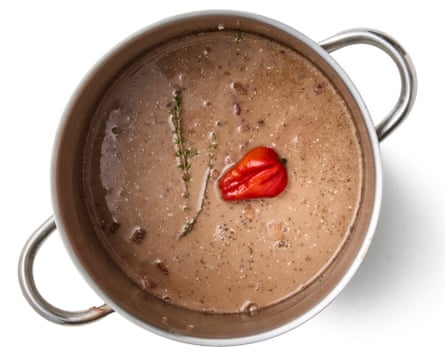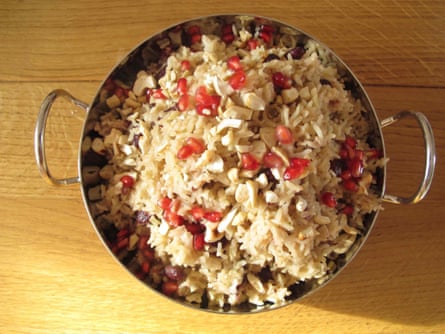More than a mere accompaniment, Rice and Peas is a cultural lodestar of the Caribbean, a dish so fundamental it is woven into the very rhythm of island life. While known by various names across the region—from the Jamaican standard to the Bahamian “peas and rice”—its core identity remains a deep, savory alchemy of creamy coconut milk, firm grains, aromatic allspice, and the signature heat of the scotch bonnet chilli. Traditionally reserved for the Sunday dinner table, its preparation is an unhurried ritual, demanding time for the “red peas,” or kidney beans, to soften and for their earthiness to infuse the cooking liquid. This liquid, steeped with garlic, thyme, and the subtle, smoky richness of bacon, is the soul of the dish. It transforms humble rice into a rich, mahogany-hued creation—a culinary embodiment of tradition, community, and the profound, layered flavours of the tropics. To master this recipe is to understand the heart of Caribbean cuisine itself.
The Cultural Cornerstone: A Sunday Rite
Across the Caribbean islands, from Kingston to Montego Bay, Rice and Peas stands not simply as a recipe, but as a central pillar of the Sunday dinner ritual. This tradition elevated the dish from an everyday carb source to a celebration—a culinary beacon marking the end of the week and the gathering of family. The dish’s ubiquity and cultural weight are often compared to the status of polenta in northern Italy or couscous in North Africa; it is the comforting, versatile bedrock upon which many other meals are built. Historically, the use of beans, particularly kidney beans—known in Jamaica as “red peas”—was practical and economical, transforming a simple ingredient into something substantial and deeply satisfying.

The preference for the distinctive red kidney bean is crucial to the dish’s authentic profile. These beans impart more than just a sweet, slightly earthy flavor; they are responsible for the rich, characteristic color of the final product. As the beans simmer, their dark pigment bleeds into the cooking liquid, which then colors the rice a beautiful, warm shade of mahogany or deep pink. While resourceful cooks might substitute black beans or pigeon peas, the Jamaican original relies on the red pea to achieve this deep visual and flavor complexity, confirming its status as a foundational element that defines the very aesthetic of the meal.
The Alchemy of Aroma and Colour: Building the Base
The process of creating authentic Rice and Peas is a testament to the fact that great cooking often requires patience. The entire flavor profile is built upon the liquid used to cook the rice, which must first be thoroughly seasoned and infused by the “peas.” Therefore, starting with dried kidney beans that are soaked overnight is non-negotiable for a truly layered flavour. Canned beans, while convenient, lack the essential starch and pigment needed to properly season and color the cooking water, relegating their use only to culinary emergencies. The bean liquor is the lifeblood of the dish, carrying the subtle salinity and the earthiness extracted during the initial, lengthy cooking stage.
Once the soaked beans are just tender, the slow infusion of aromatics begins. A whole, squashed garlic clove is added early to provide depth, but the crucial savory notes are introduced by frying and then simmering finely chopped onion and, traditionally, smoked bacon lardons. This step is a savory anchor, ensuring the final dish is rich and complex. For those opting for a meat-free version, a crucial compensatory step is necessary: incorporating a dash of soy sauce or a pinch of monosodium glutamate (MSG) at the end can effectively mimic the umami depth and mouth-feel lost from omitting the smoked pork, ensuring the vegetarian interpretation remains robust and satisfying.
Mastering the Simmer: Technique and Timing
With the kidney beans properly seasoned and softened, and the savory base established, the transition to rice cooking demands precise technique. First, the long-grain rice must be meticulously rinsed in cold water until the runoff is perfectly clear. This vital step removes excess starch, preventing the final dish from becoming an overly glutinous mess and ensuring that the rice grains remain separate, tender, and light—a hallmark of quality Caribbean cooking.

The introduction of the key flavor agents marks the true start of the rice-cooking phase. Coconut milk is stirred into the bean mixture, providing its signature creaminess and sweetness. This is immediately followed by a measured dose of ground allspice and the fragrant, woody notes of fresh thyme sprigs. Crucially, the whole scotch bonnet chilli is pushed, intact, into the rice. While some recipes suggest pricking the pepper, a whole chilli provides the necessary aromatic essence without over-committing to an overwhelming heat, adding a foundational warmth that permeates the grains without dominating the subtle sweetness. The liquid level must be checked precisely; it should sit about three centimetres above the surface of the rice to ensure even absorption and a perfectly cooked finish.
The Final, Fiery Flourish: Rest and Revelation
The final phase of cooking, surprisingly, requires little intervention but absolute adherence to timing. Once the mixture is brought to a simmer, the pot must be covered tightly and the heat reduced to the lowest possible setting. This is where the magic of steam does the work, ensuring the rice cooks evenly and absorbs the full flavor of the coconut and spices. The dish is left undisturbed for the precise duration dictated by the rice’s type—typically twenty minutes for long-grain varieties. Any lifting of the lid or stirring during this period can release the critical steam, resulting in unevenly cooked, gummy rice.

Equally important is the resting period. Once the twenty minutes of simmering are complete, the pot must be taken off the heat and left, still covered, for an additional ten minutes. This final rest allows the steam to fully redistribute within the grains, achieving a final, fluffy texture. Only then is the covering removed, and the final discard of the flavour agents—the scotch bonnet, the thyme sprigs, and the squashed garlic clove—takes place. A final, gentle fluffing with a fork aerates the grains, separating them beautifully. A final seasoning to taste, often with an optional spoonful of butter or coconut oil for added richness, brings the perfect savoury-sweet balance to completion.
A Versatile Legacy of Service
Rice and Peas has long since shed its designation as a mere accompaniment; it is often served as the centerpiece of a meal. While traditionally paired with grilled or roasted meats, or the robust flavors of stewed fish, its sheer flavour density allows it to stand alone as a main course, particularly when served with something sharp and crunchy, like a fresh, cooling salad or a simple slice of fried plantain. The combination of saturated fat, creamy coconut, complex spice, and the lingering, mild heat of the chilli creates a mouthfeel that is profoundly satisfying in its own right.
The dish’s versatility has ensured its enduring relevance, moving it from the intimate, Sunday dining room to a permanent fixture on restaurant menus throughout the world. The method, while demanding a significant time commitment for the soaking and simmering, is one of great simplicity once understood. It is a slow, careful layering of ingredients that yields a result greater than the sum of its parts. By respecting the process—by choosing the dried beans, measuring the liquid carefully, and allowing the vital rest period—the cook honors the island heritage and ensures that the finished plate is not just food, but a perfect echo of Caribbean history and soul.




